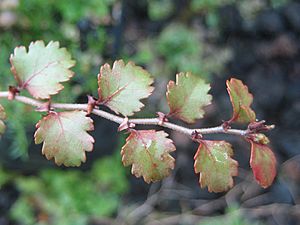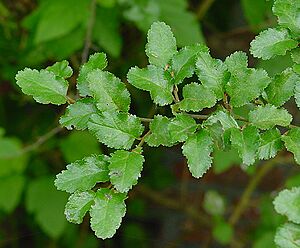Antarctic flora facts for kids

The Antarctic flora is a special group of vascular plants. These plants first grew millions of years ago on a huge ancient continent called Gondwana. Today, you can find these plants in different parts of the Southern Hemisphere. This includes places like southern South America, New Zealand, Australia, and New Caledonia. A scientist named Joseph Dalton Hooker first noticed how similar these plants were. He thought that Antarctica might have been where they came from. Another scientist, Ronald D'Oyley Good, later called this group of plants the Antarctic Floristic Kingdom. Australia has its own plant kingdom now. This is because many tropical plants from Asia came there later.
Contents
How the Antarctic Flora Began
Millions of years ago, Antarctica was much warmer. It had many plants, including forests of podocarps and southern beech trees. Antarctica was part of the supercontinent Gondwana. This giant landmass slowly broke apart due to plate tectonics. This process started about 110 million years ago.
When South America separated from Antarctica about 30 to 35 million years ago, a strong ocean current formed. This current, called the Antarctic Circumpolar Current, made Antarctica much colder. Because of this, the Antarctic flora died out on the continent itself. However, these plants are still an important part of the plant life in southern South America and Australia. These areas were also once part of Gondwana.
Some plant groups that started as part of the Antarctic Flora are still found today. You can see them in places like New Caledonia, Tasmania, Madagascar, India, New Zealand, and southern South America.
Gondwana's Breakup and Plant Life
South America, Madagascar, Africa, India, Australia, New Zealand, and Antarctica were all connected in Gondwana. This supercontinent began to split up in the early Cretaceous period (145 to 66 million years ago). India broke away first, then Africa, and then New Zealand.
By the end of the Cretaceous period, South America and Australia were still joined to Antarctica. A scientist named Gilbert Brenner found that a special southern Gondwanan flora appeared then. This plant group grew in the cooler, wet southern parts of Australia, South America, Africa, Antarctica, and New Zealand. It looked most like the plants found in modern-day southern New Zealand.
Africa and India moved north into warmer, tropical areas. They became hotter and drier. Eventually, they connected with the continent of Eurasia. Today, Africa and India have very few plants left from the original Antarctic flora.
Australia also moved north and became drier. The wet Antarctic flora moved to the east coast and Tasmania. The rest of Australia became home to plants like Acacia, Eucalyptus, and Casuarina trees. Dry shrubs and grasses also became common. Humans arrived in Australia about 50,000 to 60,000 years ago. They used fire, which changed the plant life even more. As a result, the Antarctic flora, also known as the Rainforest flora in Australia, now grows in only a few small areas. These areas make up less than 2% of Australia's land.
The woody plants of the Antarctic flora include conifers. These are found in families like Podocarpaceae, Araucariaceae, and a group called Callitroideae (part of the Cupressaceae family). There are also flowering plants like those in the families Proteaceae, Griseliniaceae, Cunoniaceae, Atherospermataceae, and Winteraceae. Well-known types include southern beech (Nothofagus) and fuchsia (Fuchsia). Many other families of flowering plants and ferns, like the tree fern Dicksonia, are also typical of the Antarctic flora.
Plants Living in Antarctica Today
Scientists have studied old rocks and soil from Antarctica. These show many well-preserved fossil wood pieces from flowering plants. This proves that temperate forests existed in Antarctica since the Late Cretaceous period. These forests were similar to those found today in southern South America, New Zealand, and Australia. It suggests that the ancient plant habitat was like the cool, wet Valdivian rainforests we see now.
Fossils show two types of conifers and at least seven types of flowering plants in ancient Antarctica. The conifers included Cupressinoxylon and Podocarpoxylon. The flowering plants included two types of Nothofagoxylon (like southern beech). Others were similar to plants in the modern Myrtaceae and Cunoniaceae families.
The continent of Antarctica itself has been too cold and dry for millions of years. This means it cannot support almost any vascular plants. The few plants that do grow there struggle with the freezing temperatures, little sunlight, low rainfall, and poor soil. They also have trouble getting water because it's mostly ice.
Antarctica's current plant life includes about 250 types of lichens, 100 types of mosses, 25-30 types of liverworts, and about 700 types of land and water algae. Only two flowering plants grow there: Deschampsia antarctica (Antarctic hair grass) and Colobanthus quitensis (Antarctic pearlwort). These are found on the northern and western parts of the Antarctic Peninsula. Some moss species found only in Antarctica (meaning they are endemic) include Grimmia antarctici, Schistidium antarctici, and Sarconeurum glaciale.
See also
 In Spanish: Flora antártica para niños
In Spanish: Flora antártica para niños


